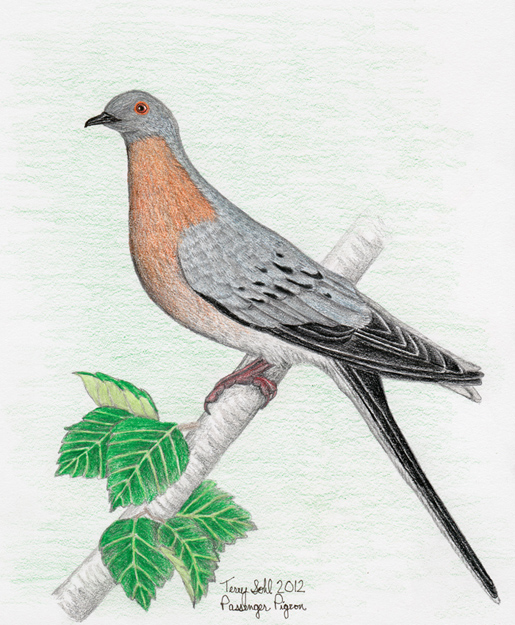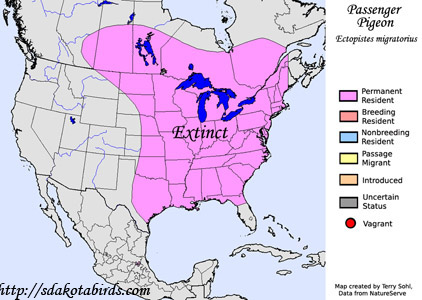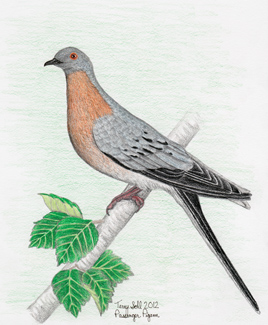| Length: 16 inches | Wingspan: 22 to 24 inches | Seasonality: Summer / Migrant |
| ID Keys: Reddish breast, bluish-gray head, rump, and back | ||
 The Passenger Pigeon was
once one of the most numerous birds in North America. From the 1600s
through early 1800s, people wrote of flocks that filled the sky as far as they
eye could see, with some individual flocks estimated at over 2 billion birds. However, the Passenger Pigeon was driven to extinction by
uncontrolled commercial hunting for their meat. Due to their tendency to
both migrate and breed in large dense flocks, they were easy targets for
hunters, who often used large mesh nets to catch them by the thousands. By
1880, there were no longer enough birds for hunting to be commercially
profitable, and the species was largely left on its own to recover.
Although several thousand birds were left at that time, populations continued to
plummet. It was thought their strong communal nature made them much less
effective breeders when populations were thin and dispersed. The last wild
specimens were collected at the beginning of the 20th century, and the last bird
of the species died in the Cincinnati Zoo in 1914. Note the photo
to the right is of a mounted specimen.
The Passenger Pigeon was
once one of the most numerous birds in North America. From the 1600s
through early 1800s, people wrote of flocks that filled the sky as far as they
eye could see, with some individual flocks estimated at over 2 billion birds. However, the Passenger Pigeon was driven to extinction by
uncontrolled commercial hunting for their meat. Due to their tendency to
both migrate and breed in large dense flocks, they were easy targets for
hunters, who often used large mesh nets to catch them by the thousands. By
1880, there were no longer enough birds for hunting to be commercially
profitable, and the species was largely left on its own to recover.
Although several thousand birds were left at that time, populations continued to
plummet. It was thought their strong communal nature made them much less
effective breeders when populations were thin and dispersed. The last wild
specimens were collected at the beginning of the 20th century, and the last bird
of the species died in the Cincinnati Zoo in 1914. Note the photo
to the right is of a mounted specimen.
Habitat: Primary nesting sites were mixed hardwood forests around the Great Lakes region. They also used forest areas as roosts in the winter.
Diet: Fed primarily on seeds, acorns, fruits, and berries, and quickly learned to take advantage of planted grain crops. They also were known to feed on insects and worms.
Breeding: Was an occasional breeder in South Dakota.
Migration: The primary breeding areas were the Great Lakes region east through New England, and southeastern Canada. Wintering grounds were primarily from Arkansas east to North Carolina, and southward to the Gulf Coast.
Interactive eBird Map: Click here for an interactive eBird Map of Passenger Pigeon sightings
Similar Species: Mourning Dove
Status: Extinct. The last bird died in the Cincinnati Zoo in 1914.
Further Information: 1) Chipper Woods Bird Observatory -- Passenger Pigeon
2) Passenger Pigeon Project - Passenger Pigeon
3) Audubon - Why the Passenger Pigeon went Extinct
Image Information: Colored pencil drawing by Terry Sohl - September 2012
| Click on the map below for a higher-resolution view |
 |
| South Dakota Status: Species extinct. Former range shown above. |
Additional Passenger Pigeon Images
Click for a higher-resolution version of these photos

